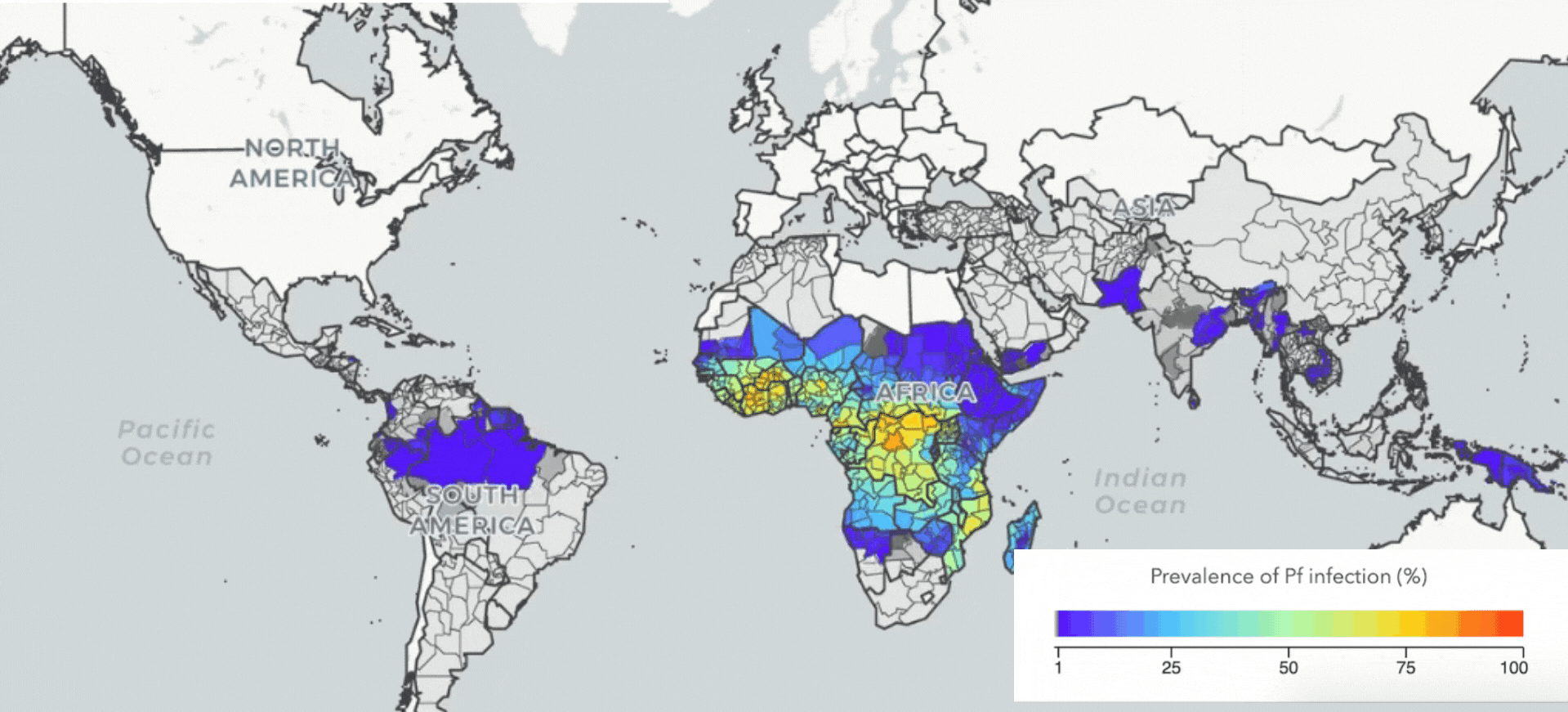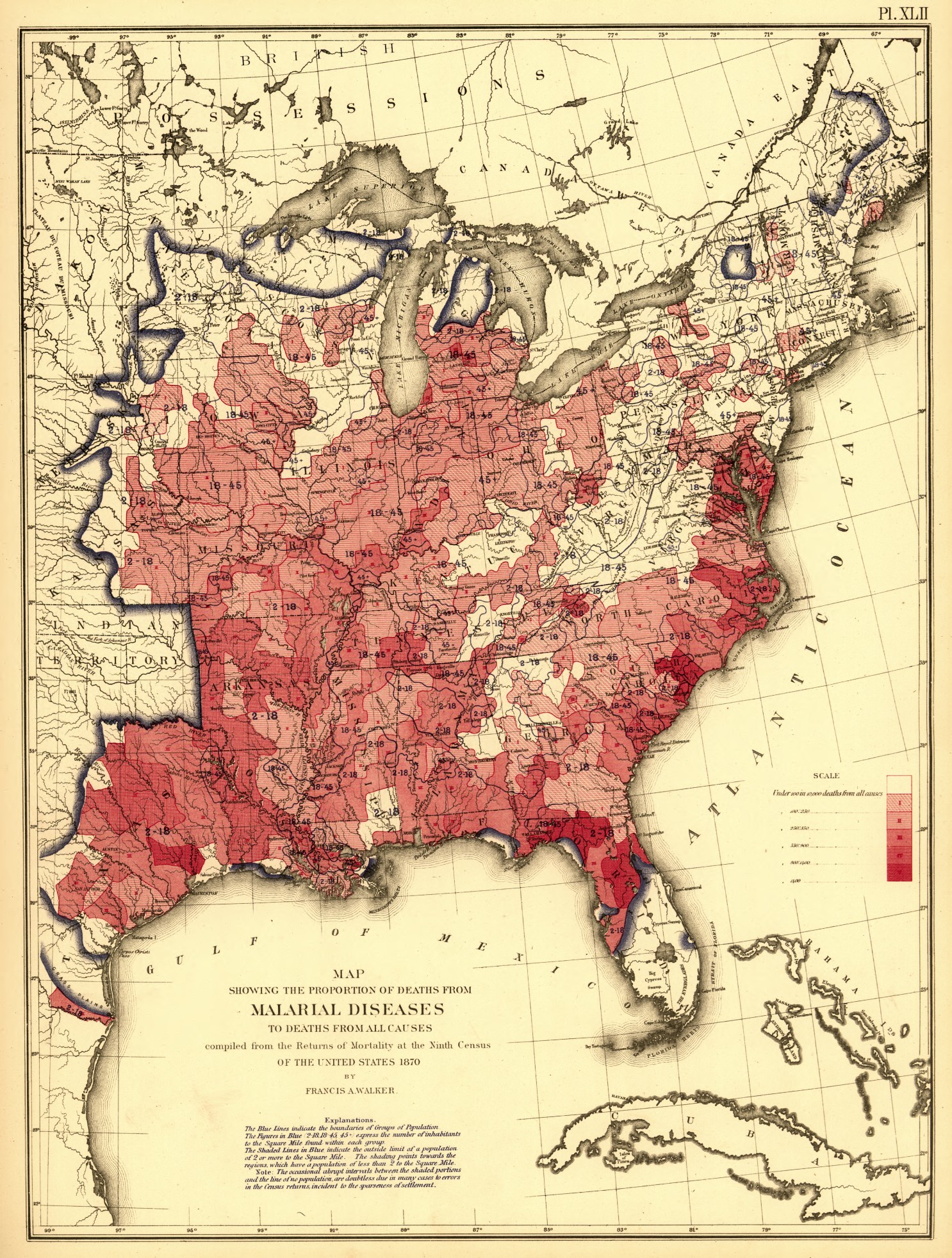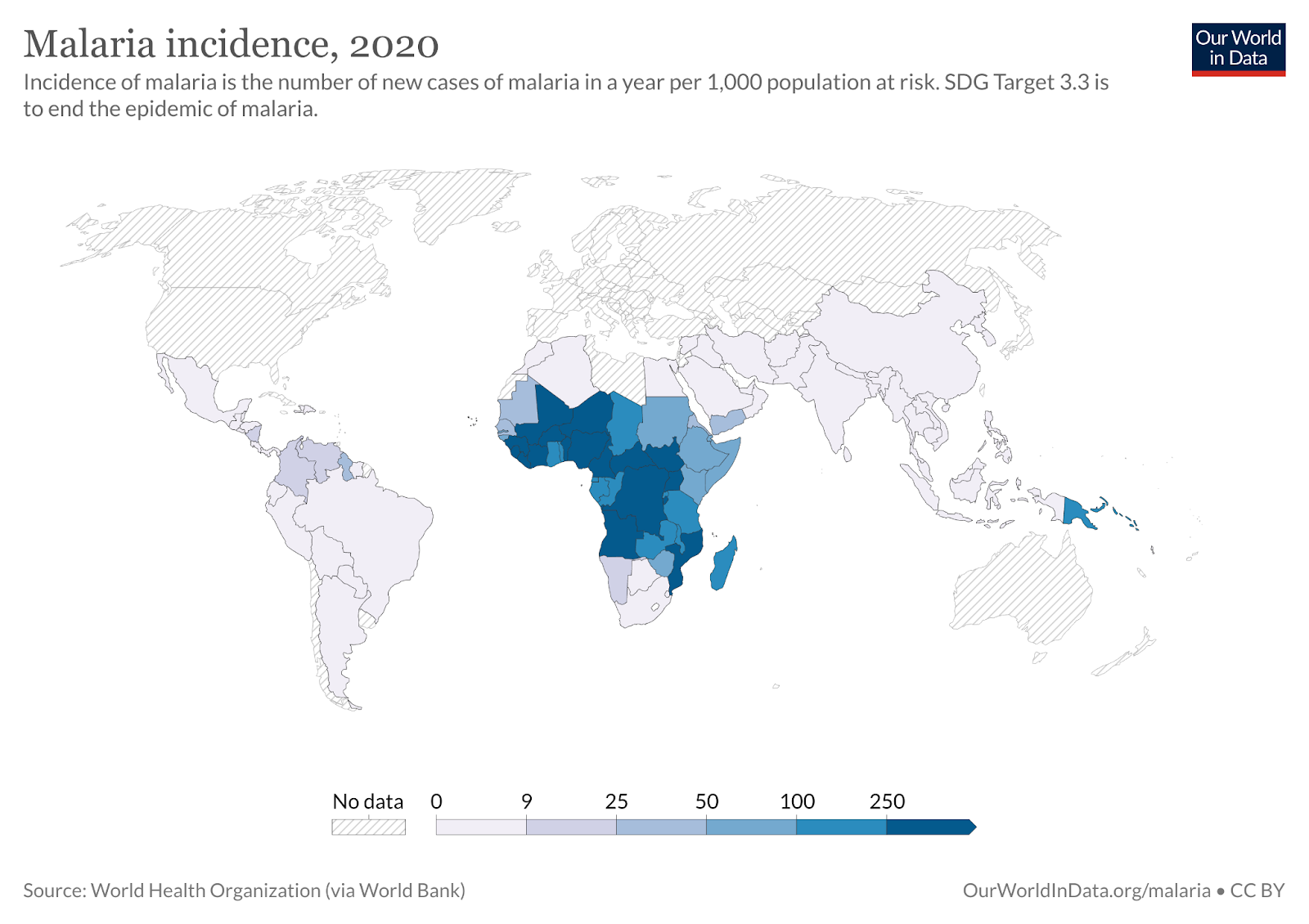World Malaria Day, inaugurated in 2017 by the United Nations World Health Organization, reminds us of malaria’s impact on humanity and the role we can take in preventing the disease. Malaria was only eradicated from areas like Europe as recently as the 1970s, and nearly half of the world’s population was still at risk of malaria in 2021. [1] Over 600,000 people died of malaria in 2021 and 247 million people contracted the disease in 2021—and three-quarters of those deaths were children under five.
Almost half of the world’s countries have eradicated malaria since 1945, and we have reason to hope that countries still affected can eradicate it as well. With significant scientific advancements, we know that effective malaria prevention can be impactful and relatively cheap. Typical interventions to prevent and treat malaria include insecticide-treated bednets, removing standing water from affected areas, and antiviral medications—and some of these interventions are relatively cheap. Only $5 USD can provide one malaria net and $7 can protect a child from malaria through malaria chemoprevention. [2] Roughly $5000 USD will provide enough bednets or seasonal medicine doses to save someone's life. [3] [4] Recent advances in vaccines against malaria and in work exploring the use of gene drives provide further hope that we could eradicate malaria from countries that are still affected.
On World Malaria Day, we encourage you to donate to Giving What We Can’s fundraiser partnering with the Against Malaria Foundation and the Malaria Consortium. Malaria is preventable and treatable; a lack of resources leaves people personally affected by the disease or affected by the loss of loved ones. Your giving can directly impact the lives of those affected by malaria: if we reached the $1 million USD fundraising goal, we could directly prevent roughly 200 deaths from malaria. Put simply, this is an area where we really can make a difference.

Plasmodium falciparum prevalence from 2000 to 2019. The decreasing amount of red, orange, and yellow represents the decreasing prevalence of one of the deadliest strains of malaria due to prevention efforts.
Data from https://vizhub.healthdata.org/lbd/malaria, animation idea by Sam Deere.
Where we've been
Malaria has been a part of human history for thousands of years, from infections in ancient Rome to the infections of several U.S. presidents. [5] Early treatment for malaria came in the form of quinine from the cinchona tree, first isolated by French chemists in 1820, and was commonly administered in the form of tonic water or the gin and tonic. [6] French surgeon Alphonse Laveran discovered the plasmodium parasite as the cause of malaria in 1880, opening up further research that would identify antimalarials like chloroquine and DDT. [7]

Proportion of deaths from malaria to deaths from all causes in the eastern United States, 1870 US Census. From Our World In Data/Statistical Atlas from the 9th Census of the United States 1870 (published 1874).
Fighting malaria was the impetus for developing public health infrastructure in a number of countries. The predecessor to the United States Centers for Disease Control was the Office of Malaria Control in War Areas, designed to limit the impact of malaria during World War II around US military bases in the Southern United States (hence its headquarters in Atlanta, Georgia rather than Washington DC). [8]
Roughly half of the world’s countries have eliminated malaria in their territories through public health efforts, including some in tropical regions where malaria is most likely to be prevalent. 79 countries eliminated malaria from 1945 to 2010, and several more since 2010. [9] Countries must achieve at least three consecutive years with no local malaria cases to apply for certification of malaria elimination by the WHO. [10] [11]
Today, Africa carries a disproportionately large amount of malaria’s disease burden, including 95% of malaria cases and 96% of malaria deaths worldwide. [12] Four countries account for over half of all malaria deaths worldwide: Nigeria, the Democratic Republic of Congo, the United Republic of Tanzania, and Niger.[13]

From Our World in Data.
Where we can go
Prevention and treatments[14]
Insecticide-treated nets or bed nets
Insecticide-treated nets provide immediate prevention to those who use them—as well as an increased future survival advantage for children that used them in childhood. [15] As the Against Malaria Foundation says, “Every ~600 nets we put over heads and beds, one child doesn't die and 500 to 1,000 cases of malaria are prevented.” [16]
Seasonal Malaria Chemoprevention
Seasonal Malaria Chemoprevention (SMC) involves the regular administration of antimalarial medication to children aged 3-59 months on a monthly basis during the period of peak malaria transmission. [17] According to clinical trials, it has been observed that SMC can prevent as much as 75% of malaria cases in children below the age of five.[18]
Vaccination
The RTS,S vaccine, brand name Mosquirix, was the first malaria vaccine approved by the WHO in 2021 for broad, public use. The vaccine required three or four doses by age 2 and only reduced hospital admissions for malaria by 30%.[19] [20]
The most effective vaccine, the R21/Matrix-M vaccine, passed the WHO’s efficacy goal of 75% for a vaccine against malaria. [21] [22] [23] Developed at the University of Oxford, the vaccine has been approved by both Nigeria and Ghana before the publication of its final-stage trial data. [24] [25]
Indoor residual spraying
This involves coating indoor surfaces with a residual insecticide, particularly effective against endophilic malaria vectors. This was once done using DDT, though concerns over the environmental impact caused a shift to the use of more expensive pesticides.
Gene drive technology or genetically modified mosquitoes
A gene drive is a genetic engineering technique that can introduce genetic variations throughout a population. [26] [27] The idea of a gene drive has existed since the 1940s, though the advent of CRISPR-based gene editing in 2013 made the idea a potential reality. [28] [29] Gene drives could immunise mosquitoes against malaria or reduce their populations, thereby diminishing the transmission of malaria to humans.[30]
Many questions and uncertainties exist around the ethics, consequences, and regulatory needs of gene drives. [31] Notably, Target Malaria is a team with country leads based at African institutions that consults with areas where genetically modified mosquitoes would be released.
Larval control/environmental modification
This may include draining swampy areas, eliminating standing water, the use of larvicides, or introducing organisms that kill larval mosquitoes (the last has proven mostly ineffective).[32]
Our role in malaria prevention and treatment
The effective altruism community has long supported evidence-based malaria prevention charities like the Against Malaria Foundation and Malaria Consortium. As evidence of our impact, these charities have received over $142 million in donations from the effective altruism community. Based on GiveWell’s 2021 cost-effectiveness estimate of $5,500 donated to the Against Malaria Foundation, donations from the effective altruism community are estimated to have saved over 25,000 lives from malaria. [33] [34]
In addition to these well-established charities, members of the community are actively engaged in developing innovative interventions and implementation methods to combat malaria. One such intervention, ZZapp Malaria, has recently reported promising results from an early trial on the Forum.
As we commemorate World Malaria Day, we recognize that the pace of progress being made to eradicate malaria is not sufficient for the need. To address this, we encourage individuals to contribute in any way possible—with one of the most effective actions being donations to highly effective charities working on the frontlines of malaria prevention.
You can donate via Giving What We Can’s fundraising page (tax deductible in the US, UK, and the Netherlands). If you're in New Zealand, Sweden, Norway, Denmark, Australia, Canada, Spain, Germany, or Switzerland, you can donate via one of Giving What We Can's campaign partners.
Our efforts today can contribute to a malaria-free future for humanity.
Further reading and action
- The WHO’s fact sheet on malaria
- Our World in Data’s article on malaria
- A report arguing for the possibility of malaria eradication by 2050 and an article summarising the study
- Evolutionary and Historical Aspects of the Burden of Malaria, Clinical Microbiology Reviews from the American Society for Microbiology
- “History of malaria and its treatments,” from Antimalarial Agents: Design and Mechanism of Action, 2020
- Recent Forum post on Ghana's approval of the R21/Matrix-M vaccine
- Metaculus questions "When will WHO recommend widespread use of a malaria vaccine that is >75% effective?" and "Will global malaria mortality rates be reduced by 90% when compared with 2015 rates, by 2030?"
- Watch Giving What We Can’s live World Malaria Day event Q&A with the Against Malaria Foundation and Malaria Consortium (premiering 25th April at 5pm London / 12pm NYC / 9am San Francisco / 2am (26th April) Sydney)
- ^
https://www.who.int/news-room/fact-sheets/detail/malaria
- ^
https://www.givewell.org/charities/top-charities
- ^
https://www.givewell.org/charities/amf
- ^
https://www.givewell.org/charities/malaria-consortium
- ^
Presidents include James Garfield, George Washington, and Abraham Lincoln. https://www.pbs.org/wgbh/americanexperience/features/garfield-know/ https://www.nps.gov/articles/000/malaria-the-evil-spirit-of-the-white-house-the-first-lady-s-illness-part-two.htm#:~:text=George%20Washington%2C%20Abraham%20Lincoln%2C%20and,the%20late%201800s%20that%20Dr.
- ^
https://www.ncbi.nlm.nih.gov/books/NBK215638/
- ^
https://ourworldindata.org/malaria#the-history-of-malaria
- ^
- ^
https://www.ncbi.nlm.nih.gov/pmc/articles/PMC3044848/
- ^
https://www.who.int/teams/global-malaria-programme/elimination/countries-and-territories-certified-malaria-free-by-who
- ^
https://www.ncbi.nlm.nih.gov/pmc/articles/PMC3044848/
- ^
https://www.who.int/news-room/fact-sheets/detail/malaria
- ^
https://www.who.int/news-room/fact-sheets/detail/malaria
- ^
https://www.cdc.gov/malaria/malaria_worldwide/reduction/index.html
- ^
https://www.science.org/content/article/malaria-preventing-bed-nets-save-children-s-lives-impacts-last-decades
- ^
https://www.againstmalaria.com/WhyNets.aspx
- ^
https://www.malariaconsortium.org/smc/what-is-smc.htm
- ^
https://pubmed.ncbi.nlm.nih.gov/22336792/
- ^
https://www.npr.org/sections/goatsandsoda/2022/05/13/1098536246/first-malaria-vaccine-hits-1-million-dose-milestone-although-it-has-its-shortcom
- ^
https://www.who.int/news/item/06-10-2021-who-recommends-groundbreaking-malaria-vaccine-for-children-at-risk
- ^
https://www.cnbc.com/2023/04/21/oxford-malaria-vaccine-rollout-could-have-major-implications-in-sub-saharan-africa-economist-says.html
- ^
https://www.vox.com/future-perfect/22399386/malaria-vaccine-r21mm-public-health-global-child-mortality
- ^
https://forum.effectivealtruism.org/posts/2gRaH8rDTc4WyGfe7/ghana-has-approved-the-use-of-a-malaria-vaccine-with-greater
- ^
https://www.reuters.com/world/africa/nigeria-regulator-grants-approval-oxfords-malaria-vaccine-2023-04-17/
- ^
https://www.reuters.com/business/healthcare-pharmaceuticals/ghana-first-approve-oxfords-malaria-vaccine-2023-04-12/
- ^
https://www.scientificamerican.com/article/gene-drive1/
- ^
https://www.synthego.com/blog/gene-drive-crispr#gene-drives-the-basics
- ^
https://wyss.harvard.edu/technology/gene-drives/
- ^
https://www.scientificamerican.com/article/gene-drives-could-fight-malaria-and-other-global-killers-but-might-have-unintended-consequences/
- ^
https://www.vox.com/science-and-health/2018/5/31/17344406/crispr-mosquito-malaria-gene-drive-editing-target-africa-regulation-gmo
- ^
https://www.scientificamerican.com/article/gene-drive1/
- ^
https://www.cdc.gov/malaria/malaria_worldwide/reduction/vector_control.html
- ^
https://openbook.fyi/org/Against%20Malaria%20Foundation
- ^
https://www.givewell.org/charities/amf
